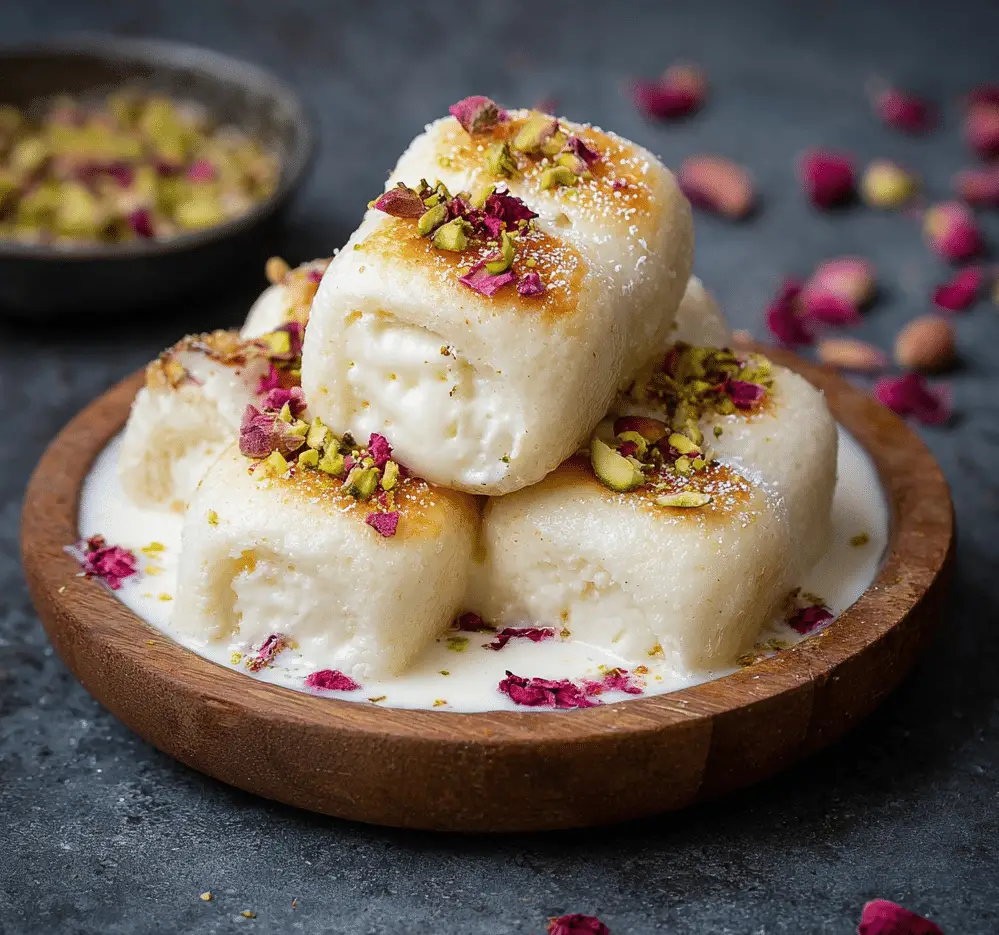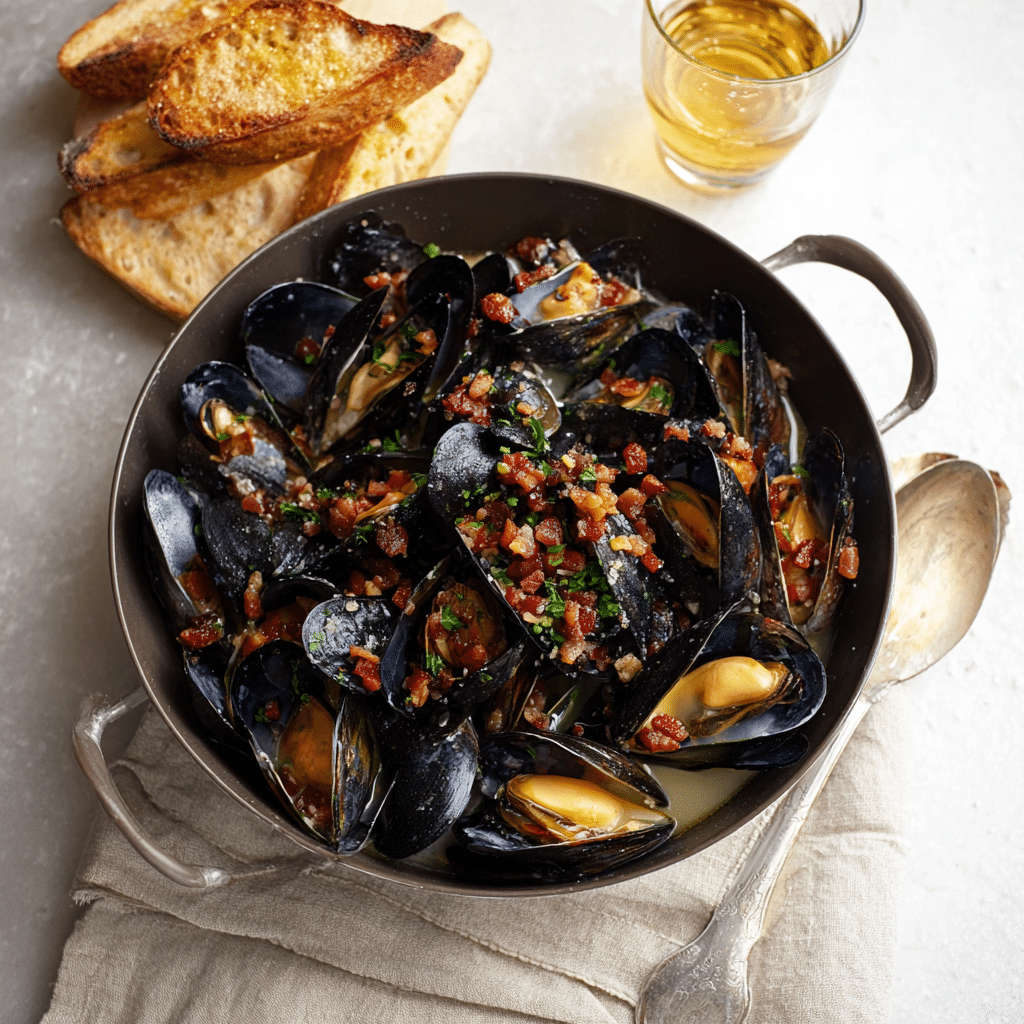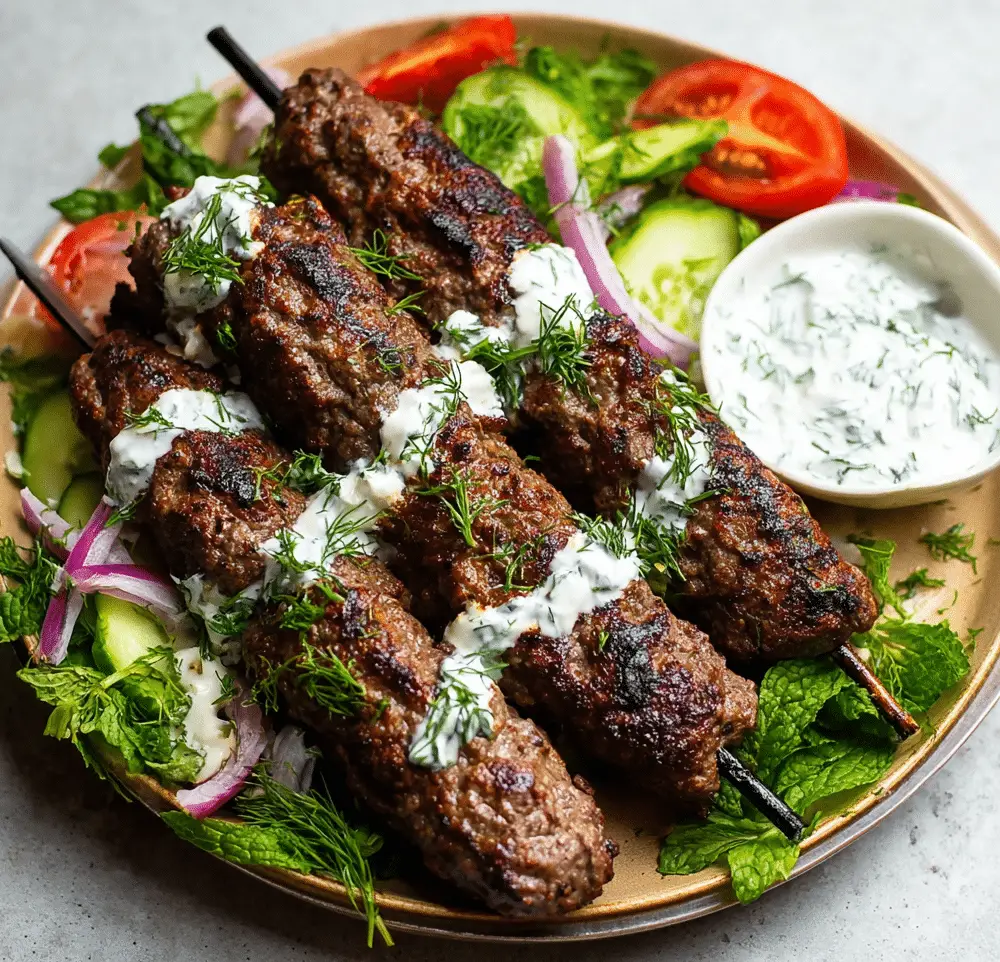The beauty of Halawet El Jibn lies in its balance of textures and aromas — a smooth, stretchy semolina cheese dough encases a luxuriously creamy ashta filling, all gently kissed with floral notes of rose and orange blossom. Drizzled with fragrant syrup and sprinkled with crushed pistachios, each bite offers a light yet indulgent experience.
This Lebanese dessert is a staple during Ramadan and festive gatherings across the Middle East. It’s a celebration of tradition, simplicity, and elegance — a recipe passed down through generations, now accessible in your own kitchen. Halawet El Jibn is the perfect make-ahead dessert for special dinners, or when you want to impress with something truly unique.
Full Recipe
Ingredients:
For the Dough:
-
1 cup (200 g) semolina
-
1 cup (240 ml) water
-
1/2 cup (100 g) sugar
-
1 tablespoon orange blossom water
-
1 tablespoon rose water
-
150 g unsalted cheese (like mozzarella or akkawi), grated
For the Ashta (Cream Filling):
-
1 cup (240 ml) whole milk
-
1 tablespoon cornstarch
-
2 tablespoons heavy cream
-
1 tablespoon sugar
-
1/2 teaspoon orange blossom water
-
1/2 teaspoon rose water
For the Syrup:
-
1 cup (200 g) sugar
-
1/2 cup (120 ml) water
-
1 teaspoon lemon juice
-
1 tablespoon orange blossom water
-
1 tablespoon rose water
For Garnish:
-
Crushed pistachios
-
Dried rose petals (optional)
Directions:
-
Prepare the syrup: In a small pot, combine sugar and water. Bring to a boil, add lemon juice, then reduce to a simmer for 8–10 minutes until slightly thickened. Stir in orange blossom and rose water. Set aside to cool.
-
Make the ashta: In a saucepan, whisk milk, cornstarch, sugar, and heavy cream. Place over medium heat, stirring constantly until it thickens (about 5–7 minutes). Remove from heat and stir in orange blossom and rose water. Let cool.
-
Prepare the dough: In a non-stick pan, mix semolina, sugar, and water. Cook on medium heat, stirring constantly, until thickened. Add the grated cheese and continue stirring until melted and fully combined. Finish with orange blossom and rose water. Spread onto a sheet of parchment paper and flatten into a rectangle using a rolling pin (about 0.5 cm thick).
-
Assemble the rolls: Once dough is cool, cut into even rectangles (about 10 cm x 5 cm). Add a spoonful of ashta to one edge of each rectangle, then roll tightly to enclose the filling.
-
Serve: Place on a serving dish, drizzle with cooled syrup, and garnish with crushed pistachios and optional rose petals.
Prep Time: 25 minutes | Cooking Time: 15 minutes | Total Time: 40 minutes
Kcal: 280 kcal | Servings: 8 rolls
What Is Halawet El Jibn?
Halawet El Jibn, sometimes spelled “Halawat al Jibn,” is one of the most iconic and beloved desserts in the Levantine culinary tradition. The name literally translates to “sweetness of the cheese” in Arabic, and it perfectly describes the essence of the dish: a soft, melt-in-your-mouth semolina and cheese dough filled with a rich, creamy ashta (clotted cream) and drizzled with fragrant syrup infused with rose and orange blossom water. The final touch — a generous sprinkling of crushed pistachios — completes this indulgent yet delicate treat.
Originating from Homs, Syria, Halawet El Jibn has since made its way into the heart of Lebanese, Palestinian, and broader Middle Eastern dessert culture. It’s often served during celebratory occasions such as Eid, Ramadan, weddings, and family gatherings — though its growing popularity means it’s enjoyed year-round across the Arab world and beyond.
A Dessert That Tells a Story
This dessert is more than just a sweet dish — it’s a celebration of Levantine identity, hospitality, and craftsmanship. Like many traditional Arabic sweets, Halawet El Jibn showcases the use of aromatics such as rose and orange blossom, two hallmark flavors of the region’s dessert repertoire. It also demonstrates the culinary art of balancing textures and temperatures — the slight chew of the cheese dough, the cold creamy ashta, the warm floral syrup, and the nutty crunch of pistachios.
The method of making Halawet El Jibn is passed down through generations. It’s a dessert that brings families together in preparation and in enjoyment. From kneading the semolina dough by hand to gently rolling each strip around a dollop of cream, every step is done with intention and care — and that love is evident in every bite.
The Role of Ashta in Arabic Desserts
Ashta, or clotted cream, is an essential component in many Middle Eastern sweets. It’s not only used in Halawet El Jibn, but also in Atayef (stuffed pancakes), Warbat (filo pastry desserts), and Knefeh. Ashta adds a rich, cooling contrast to the warm dough and syrup, creating a balanced and luxurious flavor profile.
There are several variations of ashta, depending on regional preferences and availability of ingredients. Some traditional recipes call for boiling milk with fresh bread or citrus peels, while modern versions simplify the process by using milk, cornstarch, and cream. What remains constant is its silky texture and subtle flavor that pairs harmoniously with the floral accents of rose and orange blossom water.
The Magic of Rose and Orange Blossom Waters
One of the defining features of Halawet El Jibn is its aromatic floral syrup. Unlike Western-style syrups that may rely on vanilla or spices, Middle Eastern syrups commonly use rose water and orange blossom water, two essential ingredients in the regional flavor profile.
These distilled flower waters don’t just add fragrance — they elevate the entire dessert experience. Rose water lends a slightly perfumed, almost romantic note, while orange blossom water adds freshness and citrusy undertones. When combined in syrup form, they infuse the dish with complexity and elegance without overpowering its subtle cheese and cream components.
It’s important to note that not all rose or orange blossom waters are created equal. The best results come from high-quality, natural distillations rather than artificially flavored versions. Using premium ingredients ensures the final dessert retains its authenticity and sophistication.
The Dough: Soft, Stretchy, and Uniquely Middle Eastern
What sets Halawet El Jibn apart from many other global desserts is its use of cheese in the dough. This isn’t a cheesy dessert in the way Western palates might expect; rather, the cheese is incorporated into the dough for elasticity and richness.
Traditionally, unsalted white cheese such as akkawi or nabulsi is used, though mozzarella is a common substitute in modern recipes outside the Middle East. The cheese is combined with semolina and sugar to create a pliable, slightly chewy dough that is rolled thin and filled with cream. The result is a texture unlike any other — tender, yet slightly stretchy, and beautifully neutral to let the cream and syrup shine.
Getting the dough texture just right is considered a mark of skill in Levantine kitchens. It should be soft but not sticky, pliable but not rubbery. Mastering this texture takes practice, which is why many families still prefer to make it together, combining years of shared wisdom.
Serving and Presentation
Halawet El Jibn is not only delicious but also visually stunning. The rolls are typically cut into even segments and arranged neatly on a serving tray. Once plated, they’re drizzled with the floral syrup and topped with vibrant green crushed pistachios. Some versions also include a touch of dried rose petals for added color and elegance.
This dish is often served chilled, which enhances the refreshing contrast between the warm syrup and cool ashta. However, it can also be enjoyed at room temperature. Either way, it is customary to serve Halawet El Jibn with Arabic coffee or mint tea, both of which complement the floral and creamy flavors of the dessert.
Cultural Significance and Modern Adaptations
Halawet El Jibn isn’t just a food — it’s a cultural artifact. Its presence on the table often signifies joy, hospitality, and togetherness. In many parts of the Arab world, it is still made fresh by dessert artisans in local sweet shops, where families stop by to purchase it for weekend meals or special events.
With increased globalization, this dessert has gained popularity in Western countries as well. Home cooks from around the world now seek out recipes to recreate it in their own kitchens. While purists may insist on using traditional cheeses and handmade ashta, modern cooks often use accessible substitutions without compromising too much on flavor.
Some contemporary versions even include variations like fruit-infused creams, chocolate-dipped edges, or fusion fillings with mascarpone or ricotta. Though these modern spins are creative, the original version remains unparalleled for its authenticity and deep-rooted heritage.
Health and Dietary Notes
While Halawet El Jibn is undeniably indulgent, it’s often served in small portions, making it a suitable treat in moderation. Its naturally gluten-free dough (thanks to semolina and cheese) makes it accessible for those with gluten sensitivities. Additionally, homemade versions allow for customization — including using less sugar or substituting with plant-based creams for dairy-free diets.
Still, it’s a rich dessert with full-fat dairy, sugar syrup, and nuts, so it’s best enjoyed as an occasional indulgence rather than a daily treat. For those looking to balance tradition with health-conscious choices, small tweaks can go a long way without sacrificing flavor.
Conclusion: A Sweet Symbol of the Levant
Halawet El Jibn is much more than a dessert — it is a celebration of Middle Eastern culinary artistry, heritage, and generosity. From its silky, rose-scented cream to its soft cheese dough and crunchy pistachio topping, every bite is a journey into a region rich with flavor and tradition.
Whether served during Ramadan, at a family celebration, or simply as a weekend indulgence, Halawet El Jibn reminds us of the joy that comes from shared meals and treasured recipes. Its growing popularity across the globe is a testament to its universal appeal — a dessert that crosses borders, speaks to the senses, and leaves a lasting impression on anyone lucky enough to experience it.
If you’re looking to introduce authentic Arabic flavors to your dessert repertoire, Halawet El Jibn is a beautiful place to start. It’s delicate, luxurious, and unforgettable — a true gem of Levantine cuisine.








